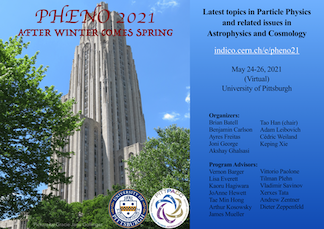Speaker
Description
Models with dark showers represent one of the most challenging possibilities for new physics at the LHC. One of the most difficult examples is a novel collider signature called a Soft Unclustered Energy Pattern (SUEP), which can arise in certain BSM models with a hidden valley sector that is both pseudo-conformal and strongly coupled. Large-angle emissions are unsuppressed during the showering process, and if the hidden sector hadrons decay hadronically and promptly back into the Standard Model, the result is a high-multiplicity shower of SM final state particles that possess more democratically distributed energies and a much higher degree of isotropy than typically seen in QCD jets. This signature presents significant challenges to trigger on and search for, due to the lack of isolated hard objects to identify in the detector. We outline an analysis strategy to look for SUEP produced by exotic decays of the Higgs boson, using both conventional cuts on event-level observables and anomaly detection methods from machine learning. We find that for some regions of dark shower parameter space, data from the HL-LHC could be used to exclude branching ratios of Higgs decay to SUEP down to a few percent.
